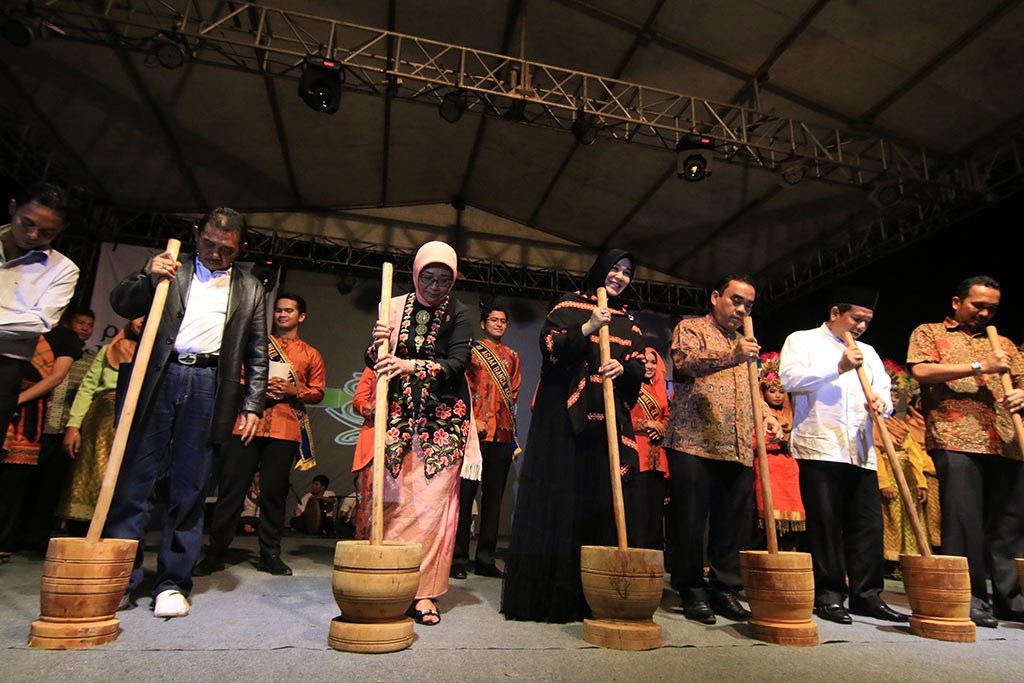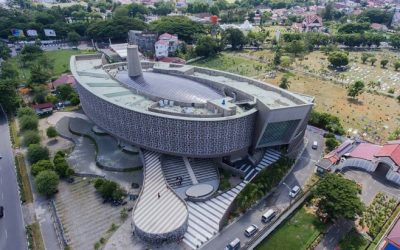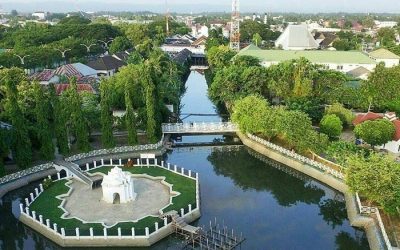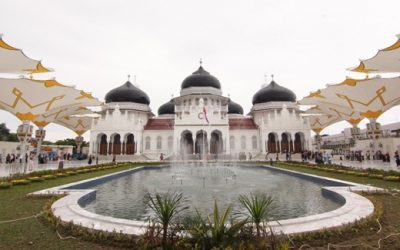Home / Batik Regions – Western Indonesia – Northern Sumatra – Aceh / Aceh Gayo Premium Coffee Festival
Cultural Destination
Embrace the spirit of the place!
Aceh Gayo Premium Coffee Festival

The Aceh coffee festival (photo: Banda Aceh Tourism)
Aceh Gayo Premium Coffee Festival
Gayo Aceh Arabica coffee is the best premium organic coffee in the world, as widely recognized by the Specialty Coffee Association of Europe (SCAE). Aceh province government holds an annual festival to celebrate the coffee tradition, called “A Cup of Aceh Coffee, A Million Flavors”. This festival is one of the long-awaited events by world coffee vendors and connoisseurs. In the festival, you could taste some varieties of premium coffee products, such as honey coffee, Aceh traditional coffee of Kupi Khop and Kupi Sareng, palm coffee, Arabica, and Robusta coffee. In 2018, the event was held from the 15th until 17th December 2018. Keep abreast for the next coffee festival in Aceh!
Tourist Attractions in Aceh
Aceh Tsunami Museum
The Aceh Tsunami Museum is a memorial monument of the biggest Tsunami disaster that
Putro Phang Royal Garden
Putro Phang Royal Garden is an expression of love built during the era of
Baiturrahman Historical Grand Mosque
The Grand Mosque of Aceh was built in 1612 during the reign of
Aceh Batik Motifs
Kerawang Tegak Aceh
The Vertical Upright (Kerawang Tegak) Motif symbolizes a person who has a strong
Discover
Indonesian
Batik
Motifs
Hiu Taliyasan
Indonesia is also home to the world’s largest fish, the whale shark (Rhincodon typus). Hiu Taliyasan refers to
Kawung
The Kawung motif was created by Sultan Agung Hanyokrokusumo (1593 – 1645) as a symbolic gift for
Ake Patra
Ake is related to the divinity and the composition of the universe. It is a symbol of
Buketan Bali
The Balinese bouquet (Buketan Bali) is a floral arrangement and the name is
Parang Rusak
Another meaning behind this motif is an unconquerable spirit, symbolized by
Bekantan Pakis
This motif represents Pakis Haji (Polystichum setiferum), an endemic plant in
Bale Lumbu
This motif signifies the welfare of the ancient Sasak society. Bale also symbolizes the
Angsa Duo
According to legend, the Angso duo batik motif is a pair of swans that are believed to have led Princess
Bintik Tujuh
The Bintik Tujuh (Seven Dots) motif has 7 white spots and green color gradation as
Burung Bidadari
Bidadari birds are endemic birds in Halmahera. This motif represents an
Srimanganti
The name of the Srimanganti motif is derived from Palace’s hallway that connects to
Teguh Bersatu
This batik motif shows the strength of the people of Kupang. It also represents a sense of
Jumputan Bintang
The word Jumputan means the tie-dye technique, while the word “Bintang” refers to
Singayaksa
The Singayaksa motif comes from the name of a place where Sultan Hasanuddin used to
Daun Lada Hitam
The black pepper motif represents the main commodity of Bangka Belitung
Insang Ikan
Insang refers to the gills of the fish. This is a typical pattern of Malay ethnic who inhabits
Dayak Taghol
Dayak Taghol has a distinctive style of four curved lines and small dots. This motif represents
Tenun Bima
The motifs are adopted from Bima woven textile. This pattern has received a great
Enggang Dayak
Local people beliefs that hornbills are an incarnation of the Commander of the Birds. It has supernatural
Prada Papua
The word “Prada” in the Javanese-Indonesian dialect means a batik textile that
Tikar Natuna
The Tikar Natuna motif is adapted from the traditional making of pandanus mats in
Ikan tambal
The word “Ikan” refers to fish. The philosophical meaning of Ikan Tambal means is
Pohon Hayat (Tree of Life)
The Batik motifs in Lampung are dominated by the acculturation of Buddhist and
Taiganja
Taiganja is a precious gold pendant that shows the social status of the Kaili family. It is
Kuda Kupang
Horses symbolize wealth. It contains noble values of virtuous characters that bring
Kerawang Tegak Aceh
The Vertical Upright (Kerawang Tegak) Motif symbolizes a person who has a strong
Honai
The Honai is inspired by the traditional house of the Papuan community living in
Besurek Rafflesia
The term “Basurek” refers to a textile that contains letters or inscriptions
Sekomandi
Its philosophical meaning is the eternal union which refers to a saying “until death do us part”
Wirasat
Wirasat or divine inspiration is a gift from God. This inspiration is symbolized by
Gorga Simeol-Meol
The Gorga Simeol-meol is a pattern of plant tendrils. it is regarded as a symbol of longevity and
Tangerang Herang
Tangerang Herang motif is a symbol of Tangerang city. The Tangerang Herang batik motif consists of
Gigi Haruan Lidi
The Gigi Haruan Lidi motif is taken from the name of the cork fish and is a symbol of
Lontara
The Lontara script itself is a typical ancient script of Bugis and Makassar communities. History records that
Pati-Pati Pinehiku
It symbolizes the hierarchy in society and the social status of the Mekongga
Tengkawang Ampiek
With its many advantages, the Dayaks use this leaf in ritual ceremonies. This plant is a symbol of
Sido Mulyo
Sidomulyo is one of the classical motifs, which is specifically used for the bride’s costume in
Merak Ngeram
The hatching peacock motif has a very deep meaning which refers to the sacrifice and
Jupri Kembang Teh
Kembang Teh illustrates the tendrils of tea plants that grow in the highlands of
Tongkonan
Toraja’s traditional house is called Tongkonan. Tongkonan is a place for
Besurek Rembulan
This batik illustrates praise for God who created the wonderful universe
Daun Sirih
This motif illustrates betel leaves that are used by Lombok communities as traditional
Desa Na Tolu
The Desa Na Tolu characteristic pattern symbolizes the Batak philosophy of existence and
Raja Ampat
Raja Ampat motif represents the marine life at Raja Ampat archipelago in
Karawo Mahkuta
Mahkuta refers to Gorontalo’s traditional crown. It represents noble characters of
Kaganga Tanah Rejang
If Batik Besurek combines Arabic calligraphy motifs, then the Kaganga batik takes
Gentala Arasy
Built as high as 80 meters, the tower also highlights the historical side of
Lipaq Sabe
Lipaq Saqbe contains a simple geometric classical motif with various flower decorations. This textile is
Kaharingan
The Kaharingan or ‘tree of life’ based on the Dayak tribes’ belief system. This tree symbolizes
Pinawetengan
The Pinawetengan Batik pattern was taken from a prehistoric inscription in
Sero Tangga
The Sero Tangga illustrates an endearing feeling and sacrifices of a person to fulfil
Daun Simpor
This motif is inspired by the Simpor plant (Dillenia Suffruticosa) which is a typical
Gamolan
This motif illustrates Gamolan, a bamboo musical instrument of Lampung that is
Tampuk Manggis Sasirangan
The motif illustrates the philosophy of the mangosteen fruit, which is
Salakanagara
Salakanagara batik motif illustrates the first kingdom in the Betawi land
Ukir Sentani
The Ukir motif is a batik motif that is inspired by various traditional Sentani wood carvings
Cengkeh
The clove flower motif is the main commodity of the Tolitoli Regency. This motif represents
Tifa Totobuang
The batik motifs illustrate Maluku’s traditional music instrument called
Karawo Pinang
Pinang refers to the Palm areca tree. This motif is considered as the original
Rangkiang
The word “Rangkiang” refers to the rice granary in the Minangkabau language. It symbolizes
Tanah Liek
The word “Tanah Liek” refers to clay in Minang language. It is also known as
Bomba Mawar
This motif means sacred love for family, kingdom, and God; It also illustrates
Pala Salawaku
This motif illustrates the unique weapons of the Maluku region, namely
Leuit Sijimat
This motif reflects the daily activities of the Baduy tribe in Banten. The main ornaments of batik motif consist of:
Lok Baintan Floating Market
As you can imagine, the most authentic thing is that you can buy things and even
La Galigo
La Galigo is a literary work of the Buginese Epic that has 300 thousand epic lines. It is considered even
Dayak Kamang
Kamang motif is generally found in the Dayak tribe shield because it is believed to
Tubo Kelapa
Coconut tree is a symbol of a good character and strong mentality. It illustrates the more success a person, the more
Rumah Mamuju
the Batik motif illustrates the house of Mamuju King with the stairs, located on the left of the wooden stage house
Gonggong Beruntun
This motif illustrates that a person should maintain a positive attitude and
Sandeq
Sandeq Boat is a symbol of the maritime importance of the West Sulawesi region. The greatness of
Mahkota Siger
Siger is the crown of a noblewoman in ancient time. It is a symbol of femininity, strength, and



